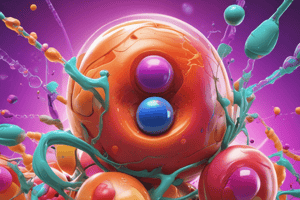Podcast
Questions and Answers
What is a potential consequence of growth hormone deficiency pre-puberty?
What is a potential consequence of growth hormone deficiency pre-puberty?
- Accelerated pubertal development
- Increased metabolism
- Delayed skeletal maturation (correct)
- Excessive growth of facial features
Which imaging study is primarily used to assess bone age in children suspected of growth hormone deficiency?
Which imaging study is primarily used to assess bone age in children suspected of growth hormone deficiency?
- CT scan of the skull
- MRI of the brain
- X-ray of the hand (correct)
- Ultrasound of the abdomen
What is Laron syndrome primarily caused by?
What is Laron syndrome primarily caused by?
- Genetic mutations of the growth hormone receptor gene (correct)
- Pituitary adenomas
- A deficiency in thyroid hormones
- Excess secretion of growth hormone
Which symptom is NOT associated with lack of growth hormone post-puberty?
Which symptom is NOT associated with lack of growth hormone post-puberty?
Which of the following is a characteristic manifestation of acromegaly?
Which of the following is a characteristic manifestation of acromegaly?
Which hormone stimulation test is commonly used in the diagnosis of growth hormone deficiency?
Which hormone stimulation test is commonly used in the diagnosis of growth hormone deficiency?
What is one of the psychological effects associated with growth hormone deficiency post-puberty?
What is one of the psychological effects associated with growth hormone deficiency post-puberty?
What typically precedes the condition of acromegaly in adults?
What typically precedes the condition of acromegaly in adults?
Which of the following conditions is characterized by GH insensitivity?
Which of the following conditions is characterized by GH insensitivity?
What is a common clinical assessment performed for suspected growth hormone deficiency?
What is a common clinical assessment performed for suspected growth hormone deficiency?
What is the primary role of IGFBP-3 in the circulation of IGF?
What is the primary role of IGFBP-3 in the circulation of IGF?
Which of the following is a stimulus for the secretion of IGF-1?
Which of the following is a stimulus for the secretion of IGF-1?
GH deficiency before puberty typically results in which of the following growth velocities?
GH deficiency before puberty typically results in which of the following growth velocities?
What effect does growth hormone primarily have on glucose metabolism?
What effect does growth hormone primarily have on glucose metabolism?
Which of the following proteins is associated with growth inhibition when present in high amounts?
Which of the following proteins is associated with growth inhibition when present in high amounts?
Which statement is true regarding the IGF family?
Which statement is true regarding the IGF family?
What is a common characteristic of individuals with GH deficiency pre-puberty?
What is a common characteristic of individuals with GH deficiency pre-puberty?
The effect of increased IGFBP levels on IGF activity is typically to:
The effect of increased IGFBP levels on IGF activity is typically to:
What does high IGFBP-3 correlate with in terms of growth effects?
What does high IGFBP-3 correlate with in terms of growth effects?
What is a key function of IGFBPs in relation to IGF?
What is a key function of IGFBPs in relation to IGF?
Flashcards
Growth Hormone Deficiency (Pre-puberty)
Growth Hormone Deficiency (Pre-puberty)
A condition where the body doesn't produce enough growth hormone before puberty, leading to slow growth, delayed puberty, and potential complications like obesity and hypoglycemia.
Delayed Tooth Development
Delayed Tooth Development
A symptom of growth hormone deficiency in children, where teeth erupt later than expected.
Bone Age
Bone Age
A measure of skeletal maturity based on X-ray images of the hand, used to assess growth and development.
Laron Syndrome
Laron Syndrome
Signup and view all the flashcards
Genetic IGF Deficiency
Genetic IGF Deficiency
Signup and view all the flashcards
Growth Hormone Deficiency (Post-puberty)
Growth Hormone Deficiency (Post-puberty)
Signup and view all the flashcards
Gigantism
Gigantism
Signup and view all the flashcards
Acromegaly
Acromegaly
Signup and view all the flashcards
Pituitary Tumor
Pituitary Tumor
Signup and view all the flashcards
Sleep Apnea
Sleep Apnea
Signup and view all the flashcards
Direct Effects of Growth Hormone
Direct Effects of Growth Hormone
Signup and view all the flashcards
IGF Family: Receptors and Binding Proteins
IGF Family: Receptors and Binding Proteins
Signup and view all the flashcards
IGFBPs: Functions
IGFBPs: Functions
Signup and view all the flashcards
Most abundant form of IGFBP
Most abundant form of IGFBP
Signup and view all the flashcards
IGFBP-1: Growth Inhibition
IGFBP-1: Growth Inhibition
Signup and view all the flashcards
Insulin-like Growth Factor 1 (IGF-1)
Insulin-like Growth Factor 1 (IGF-1)
Signup and view all the flashcards
Insulin-like Growth Factor 2 (IGF-2)
Insulin-like Growth Factor 2 (IGF-2)
Signup and view all the flashcards
Adipose Tissue Effects of Growth Hormone
Adipose Tissue Effects of Growth Hormone
Signup and view all the flashcards
Extra Skeletal Tissue Effects of Growth Hormone
Extra Skeletal Tissue Effects of Growth Hormone
Signup and view all the flashcards
Study Notes
Effects of Growth Hormone (GH)
- GH has direct effects on various tissues and organs
- Increases amino acid (AA) uptake
- Increases protein synthesis
- Decreases protein breakdown
- Influences glucose entry into cells
- Directly alters lipid metabolism
- Decreases glucose uptake
- Increases lipolysis (fat breakdown)
- Leads to increased free fatty acids (FFA)
- Results in insulin resistance
- Causes hyperglycemia (high blood glucose)
- Increases insulin secretion
- Stimulates IGF-1 production
- Stimulates gluconeogenesis
- Stimulates glycogenolysis
- Impacts protein synthesis
- Affects AA uptake
IGF and Insulin Receptors
- IGF-1, Insulin, and IGF-1 receptors share structural similarities
- Hybrid receptors exist between insulin and the IGF-1 receptor
- Metabolic effects and mitogenic effects are both influenced by these receptors
IGF Family: Receptors and Binding Proteins
- IGF binding proteins (IGFBPs) are crucial for IGF function
- IGFBPs bind circulating IGFs with high affinity
- They act as carriers for IGFs in the bloodstream
- Prolong the half-life of IGFs
- Regulate IGF access to its receptors
- Function through receptor interaction, regardless of the presence of IGFs
Insulin-like Growth Factor Binding Proteins (IGFBPs)
- IGFBPs bind circulating IGFs with high affinity
- Act as carriers for IGFs
- Prolong IGF half-life
- Regulate IGF access to receptors
- Function independent of IGFs
IGFBPs—Modify IGF Activity
- IGFBP-3 is the most prevalent form of IGFBP
- Main carrier of IGF in circulation
- Promotes somatic growth related to IGF
- Associated with growth stimulation
- IGFBP-1 is typically present in small amounts
- Associated with growth inhibition
Binding Proteins Regulate Free IGF Availability
- Binding proteins influence IGF availability to receptors
- Decidual IGFBP-1 and placental IGFs have critical roles during implantation
- High levels of placental IGF with low levels of decidual IGFBP-1 lead to abnormal invasion
- Controlled invasion leads to a normal placenta
- Low levels of placental IGF with high levels of decidual IGFBP-1 lead to shallow implantation, abortion, and placental dysfunction
- High levels of both are linked to tubal pregnancies and abnormal placental structures (increta/percreta)
Insulin-like Growth Factors - Somatomedins
- IGF-1 and IGF-2 are somatomedins
- IGF-1 (somatomedin-C):
- 70 amino acids
- 50% homology with insulin
- Stimuli for secretion: GH, nutritional status
- IGF-2:
- 67 amino acids
- 70% homology with insulin
- Stimuli for secretion: Nutritional status, GH
Bone Cell-Specific Effects of IGFs
- IGFs promote bone cell proliferation and maturation
- Regulate the stem cells pool and lineage commitment
- Affect mesenchymal and hematopoietic stem cells
- Influence osteoclast activity and fusion-induced multinucleation
- Impact osteocyte network integrity
- Promote differentiation and mineralization of osteoblasts
- Affect growth plate zones
Other Effects of Growth Hormone
- Adipose tissue: Increased lipogenesis
- Extra skeletal tissue: Cell growth proliferation and protein synthesis
- Blood glucose: Overall increase in plasma glucose, insulin resistance, decreased glucose uptake, and pituitary diabetes
GH Hormone Deficiency: Pre-Puberty
- Most common pituitary hormone deficiency in children
- Isolated or accompanied by deficiency in other pituitary hormones
- Panhypopituitarism: Rare condition – reduced production of all pituitary hormones
- GH deficiency leads to slow growth and short stature
Growth Hormone Deficiency: Pre-puberty Manifestations
- Growth failure: Height below 3rd percentile
- Slow growth velocity: <6 cm/year before age 4, <5 cm/year from age 4 to 8, <4 cm/year before puberty
- Short stature
- Normal proportionality
- Skeletal maturation delayed by more than 2 years
- May have delayed tooth development
- Delayed or absent pubertal development
- Relative obesity
GH Pre-Puberty Deficiency: Clinical Assessment
- Height and weight data are recorded on a growth chart
- Imaging studies: X-rays (bone age), MRI (pituitary gland and hypothalamus)
- Hormone and binding protein measurements
- GH stimulation tests (arginine)
Growth Deficiencies Unrelated to GH Deficiency
- Laron syndrome: GH insensitivity or primary IGF-1 deficiency
- Rare genetic disease (autosomal recessive manner)
- Genetic mutations in the growth hormone receptor gene
- Defect in GH and IGF-1 signaling pathway
- Genetic IGF deficiency
- Nutritional neglect
Undersecretion Post Puberty
- Lack of GH leads to altered metabolism, increased adiposity, excessive tiredness, increased cardiovascular disease (CVD), anxiety, depression, and reduced quality of life
Over-Secretion of GH
- Age-dependent Gigantism (prepuberty)
- Post-puberty Acromegaly
Acromegaly (Over-Secretion)
- Rare condition, develops between ages 30-50
- Mostly due to benign pituitary tumors (>99% of cases)
- Symptoms include thickened skin, coarse facial features, enlarged hands, feet, lips, nose, and tongue; jaw protrusion; thickened ribs, barrel chest, organ enlargement; cardiovascular (CVS) disease; upper airway obstructions, sleep apnea; carbohydrate intolerance, pituitary diabetes, and general tiredness
Fetal Growth
- Fetal growth is controlled by various factors, including growth hormones.
Studying That Suits You
Use AI to generate personalized quizzes and flashcards to suit your learning preferences.
Related Documents
Description
This quiz explores the complex effects of Growth Hormone (GH) on various tissues and its relationship with Insulin-like Growth Factor (IGF). Learn about GH's impact on metabolism, protein synthesis, and its interactions with Insulin receptors. Test your knowledge on the roles of IGF and its binding proteins in metabolic functions.





